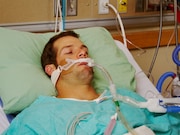Higher levels of wakefulness seen in those who pass the spontaneous breathing test and are extubated
THURSDAY, March 7, 2019 (HealthDay News) — Mechanically ventilated patients who pass a spontaneous breathing trial (SBT) and are extubated reach a higher level of wakefulness, indicated by a higher odds ratio product (ORP), according to a study published online March 1 in the American Journal of Respiratory and Critical Care Medicine.
Martin Dres, M.D., from St. Michael’s Hospital in Toronto, and colleagues recorded electroencephalogram 15 hours prior to SBT in mechanically ventilated patients. The ORP was calculated from four electroencephalogram frequency bands relative to one another, ranging from full wakefulness to deep sleep.
Thirty-seven of the 44 patients enrolled had technically adequate signals. The researchers found that 11 (30 percent), eight (21 percent), and 18 (49 percent) patients passed the SBT and were extubated, passed the SBT but were not deemed ready for extubation, and failed the SBT, respectively. Pathological wake and atypical sleep were highly prevalent; between the groups, the distribution of classical sleep stages was similar. Compared with other groups, extubated patients had higher mean ORP and the ORP was >2.2 for a greater proportion of time for these patients. Patients who failed the SBT had significantly lower correlation between the right and left hemispheres ORP (R/L); the area under the receiver operating characteristic curve of R/L ORP was 0.91 for predicting failure.
“We now have a monitoring tool of the brain that can help us address questions of major importance for the outcome of patients in the intensive care unit,” a coauthor said in a statement.
Several authors disclosed financial ties to the medical device and appliance industries.
Copyright © 2019 HealthDay. All rights reserved.








